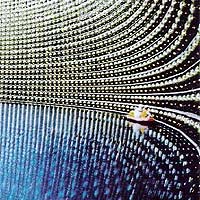Fan Micro Car DIY STEM Kit
$9.99$4.95
Posted on: Jul 8, 2004

The detector consists of an inner volume and an outer volume which contain 32,000 tons and 18,000 tons of pure water respectively. The outer detector is used to veto entering cosmic ray muons and is used as a buffer to keep radiation emitted by the surrounding rock and walls from entering the inner volume. The inner detector has 11,200 photomultiplier tubes (PMTs) attached to the bottom, top and sides facing inward. The PMTs collect the pale blue light called Cerenkov light which is emitted by particles travelling fast as light in the water. By measuring the direction and intensity of this light,information about particle interactions such as neutrino interactions or proton decay can be determined. Compared to Kamiokande, Super-Kamiokande has ten times the volume and twice the density of PMTs. Construction of the detector was completed in 1995 and observation began on April 1, 1996.
Kamioka Observatory, ICRR (Institute for Cosmic Ray Research), The University of Tokyo
A new analysis of atmospheric neutrino data by a team of international scientists has shown for the first time the distinctive pattern of neutrino oscillation that has eluded researchers until now.
The team of scientists, known as the Super-Kamiokande Collaboration, includes a UCI group led by professors Henry Sobel and David Casper. Sobel, professor of physics and astronomy, is one of the two U.S. spokespersons for the experiment. The team will report its findings in a forthcoming issue of Physical Review Letters.
"Our findings confirm that neutrinos have mass and that they change state from one type of neutrino to another," said Sobel, who is principal investigator at UCI for the experiment and a member of the experiment’s Executive Committee.
Super-Kamiokande, a 50,000-ton detector located in the Kamioka Mozumi mine in Japan, is designed to search for proton decay, observe cosmic rays and detect neutrinos. One of the fundamental particles that make up the universe, the neutrino was first detected experimentally in the 1950s by the late Frederick Reines, UCI distinguished professor emeritus of physics, who received the 1995 Nobel Prize for this work.
Neutrinos are light, electrically neutral and able to traverse great distances in matter. They generally pass right through the Earth unscattered, but, occasionally, one will interact in the Super-Kamiokande detector to produce a subatomic particle such as a muon or an electron.
Atmospheric neutrinos are produced by high-energy collisions of cosmic rays with the Earth’s upper atmosphere and come in two types, or "flavors," called electron-type and muon-type.
In 1998, the Super-Kamiokande Collaboration reported the discovery of neutrino oscillation – a term used to describe neutrinos changing from one flavor to another – by observing that the number of upward-moving muon-neutrinos, which had traveled a long distance to the Super-Kamiokande detector through the entire Earth, was smaller than the number of downward-moving muon-neutrinos, which had traveled a short distance from the upper atmosphere to the underground detector. The Super-Kamiokande Collaboration showed that the muon-neutrino was most likely changing into a third flavor, called the tau-neutrino, that is not produced in the cosmic ray collisions.
In the theory of neutrino mixing, the probability that a neutrino of one flavor changes into another is a sinusoidal function of the ratio of distance traveled (L) divided by the neutrino energy (E). The distinctive pattern predicted by this theory is that the flavor change probability should dip toward zero and then recover as the L/E ratio increases in value. For this analysis of the atmospheric neutrino data, the Super-Kamiokande physicists invented a new method to select only those events with very good measurements of travel distance and neutrino energy.
In the 1998 analysis, the distinctive oscillatory pattern was washed out since many of the neutrino events had poor measurements of the travel distance or neutrino energy. With approximately twice as much data now recorded compared to 1998 and greatly improved techniques since then, the new analysis used only 20 percent of the entire atmospheric neutrino sample of 14,000 events, but each event selected was assigned a well-determined value of travel distance (L) and neutrino energy (E). The number of neutrino events was then studied as a function of the ratio L/E. The data showed a prominent dip at a value of L/E, consistent with the theory of neutrino mixing.
According to theory, neutrinos may change from one flavor to another only if neutrinos have mass. Therefore, the initial discovery of neutrino oscillation also was interpreted as the first evidence that neutrinos have mass. In the past, a few unusual theories attempted to explain the deficit of upward-moving muon neutrinos, such as the case where neutrinos decay to other particles. The new analysis by Super-Kamiokande rejects those theories since they do not predict the oscillatory pattern. The new measurement represents the most precise measurement of the neutrino mass difference to date.
The Super-Kamiokande Collaboration includes scientists from institutions in Japan, the United States and Korea. Principal funding for the experiment is provided by the Japanese Ministry of Education, Science, Sports, and Culture; the U.S. Department of Energy; and the National Science Foundation. In addition to advancing our understanding of basic science, the collaboration has established a strong international partnership between the Japanese and American teams.
For more information, please visit:
http://www.ps.uci.edu/~superk/superk-uci-home.html
http://www-sk.icrr.u-tokyo.ac.jp/doc/sk/index.html
 'An expert is someone who knows some of the worst mistakes that can be made in his subject and how to avoid them.'
'An expert is someone who knows some of the worst mistakes that can be made in his subject and how to avoid them.'